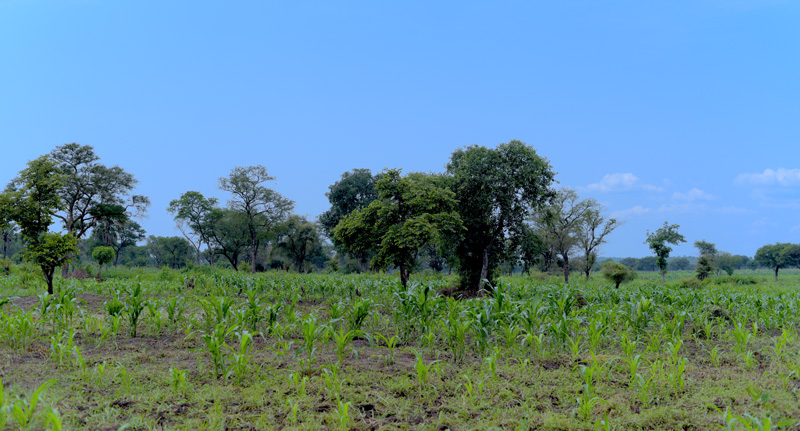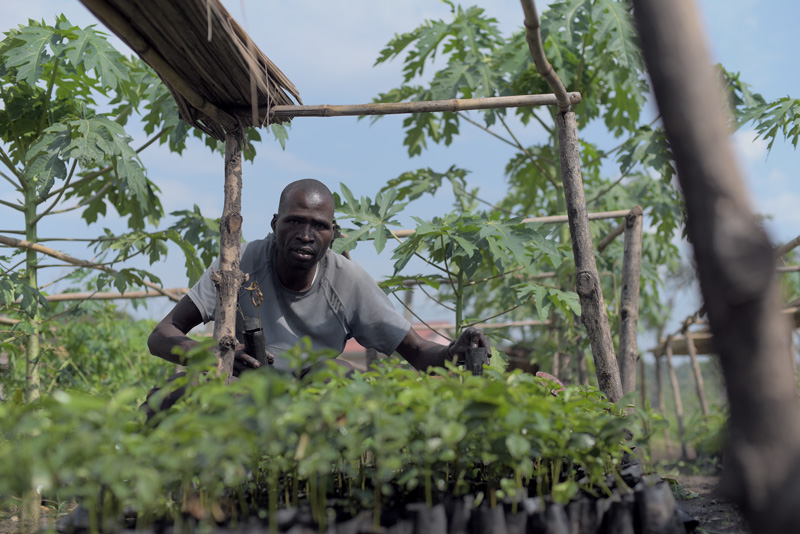A decade of civil conflict and political instability in South Sudan has led to the largest ongoing refugee crisis in Africa. More than 2 million people have fled, most settling in neighboring countries such as Kenya, Sudan, and Uganda. To prepare food and build homes, refugees routinely collect firewood from forests surrounding settlements, putting pressure on local ecosystems already stressed by deforestation.
In northern Uganda’s Palorinya Refugee Settlement, local officials have partnered with the nonprofit Wild Forests and Fauna (WildFF) to help refugees increase nearby tree coverage. Their efforts have shown that planting fruit and timber trees boosted reforestation efforts and offered refugees a source of food and income.
Deforestation, Development, and Climate Change
Over the past 2 decades, Uganda has lost a million hectares of tree coverage to development associated with cropland expansion and urbanization, according to Global Forest Watch. The dry forests in northern Uganda, ripe for both legal and illegal logging, are among the most vulnerable ecosystems in the world, said Jason Scullion, a professor of environmental studies at McDaniel College in Maryland and cofounder of WildFF.
“When the distance covered for collecting firewood increases, there are high chances of school dropout.”
Refugees in the region face difficult living conditions in an increasingly sparse forest. Overharvesting can lead to desertification, and as fuel resources dwindle, people are forced to take longer journeys in search of wood. Children, who are often tasked with collecting wood, lose time in school. “We realized that when the distance covered for collecting firewood increases, there are high chances of school dropout,” said Drama Patrick, the forest officer for Uganda’s Moyo District.
In addition, northern Uganda’s dry season is getting longer and drier because of climate change, Scullion said. The shade and moisture that trees provide are becoming even more critical to the well-being of the community and the ecosystem.
A Plan for Planting
Reversing deforestation in the region is a “massive challenge,” said Jamon Van Den Hoek, a geographer at Oregon State University who was not involved with the study.
To address the challenge and increase tree cover, WildFF, the Moyo District government, and people living in the settlement are working together to plant tree seedlings. Fruit trees such as jackfruit, mango, moringa, and papaya, as well as fast-growing timber species, not only provide firewood and building materials but also could be a source of food and income for those living in the community.
Between 2018 and 2021, people living in the settlement planted 500,000 fruit and fuelwood saplings provided by WildFF and the government. In 2018, however, only 55% of the saplings survived. Many were lost to flooding, scorched by sunshine, eaten by goats, or parched by a lack of rain.

To boost sapling success, WildFF and local officials changed their distribution methods. They allocated seedlings ahead of the rainy season and provided more training for people in the camp. “You shouldn’t expect great results if you’re just giving people seedlings,” Scullion said. “They need technical support, particularly around watering and pest management.” By 2019, the survival rate had increased to 76%.
The Reforestation Challenge

Replanting alone is not enough to sustain the Palorinya community. Between 2018 and 2021, recognizing the need to reduce demand on the surrounding forests, WildFF and the Moyo District helped community members build 12,820 fuel-efficient cooking stoves, which serve 42% of the camp’s population. The stoves halved the amount of firewood people need, Patrick said. With the more efficient stoves, “I’m not going every day for firewood,” a mother living in Palorinya said, “and children don’t need to collect it.”
Together, focusing on replanting trees and reducing demand for them through efficient cookstoves “does seem to be successful at the smaller scale,” said Joanna Trewern, manager of the WildFF Palorinya project.
Reforesting the region will provide shade and flood stabilization, reduce soil erosion, increase soil moisture, and boost carbon sequestration, said Sarah Juster, a doctoral student at Virginia Tech who studies tree planting programs and has conducted research in northern Uganda. Growing trees to harvest fruit and timber for sale is also very important, she said, as there are “few livelihood and development opportunities” in the settlement. Juster was not involved in the project.

The 500,000 seedlings planted during the project represent recovery of only 3.4% of total tree loss in and around the settlement, Scullion explained. He and Trewern said that to be able to reverse forest loss, their efforts must be scaled up, massively. To fulfill the needs of the refugees and recover the amount of forest loss, “we are going to need to plant plantations,” Scullion said.
—Santiago Flórez (@rflorezsantiago), Science Writer

